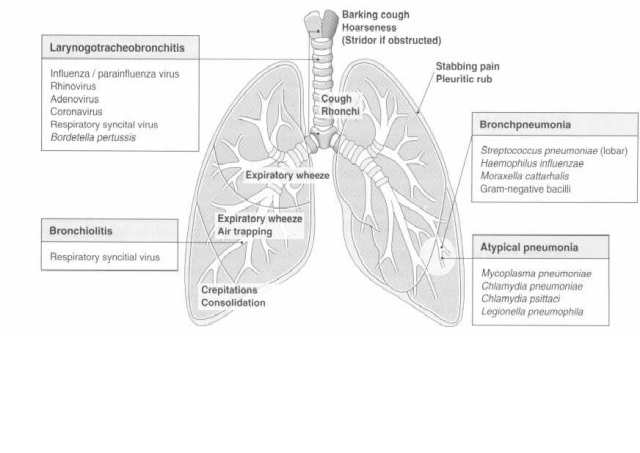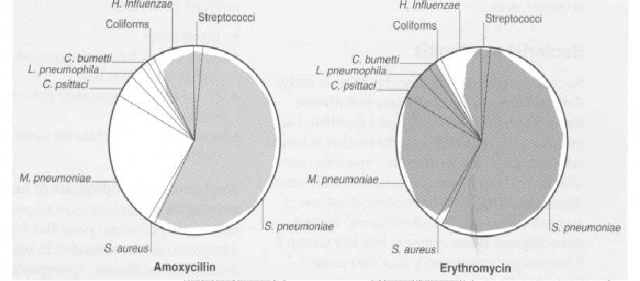The lower respiratory tract is defined as below and including the larynx. Due to the mucociliary escalator, the complex and abundant bacterial flora of the upper tract is much reduced in the larynx and trachea, and the bronchi are sterile in health. Respiratory tract infections are the most frequent cause of GP consultation. The great majority of infections are, however, self-limiting, and a provisional diagnosis should be based upon the signs and symptoms.
Airway infection Although infection in the larynx and/or trachea and/or the bronchi may occur at any age, it is extremely common in the young (croup) and in elderly smokers.
- The diagnosis of Bordetella pertussis infection should be made clinically on the basis of the characteristic severe paroxysmal spasmodic ‘whooping’ cough, as laboratory confirmation is slow and unreliable. Erythromycin may reduce spread, but it is rarely possible to give the antibiotic sufficiently early for this to be worthwhile; vaccination is more helpful.
- Influenza may be complicated by super-infection with bacteria, especially
pneumococcal and staphylococcal pneumonia. Influenza vaccine should be given to all
‘ at risk’ persons in the autumn, and the drug amantidine may be useful if given early in
infection.
- RSV causes a severe bronchiolitis in those aged less than 2 (and the elderly), which may either be fatal or produce sufficient lung damage to bring about asthma later in life. It is easily transmitted within hospitals but may respond to the drug ribavirin.
Parenchymal infection (pneumonia) Pneumonia is infection involving the lung interstitium manifest as fever, increased respiratory difficulty and cough productive of purulent sputum. It is most commonly caused by a bacterium in adults, detectable by culture of sputum (not saliva).
In contrast to bronchopneumonia, in atypical pneumonia there is less production of sputum, but the systemic symptoms and chest X-ray changes are greater than might be suspected given the few signs on chest examination. The severity of pneumonia and likely outcome can be judged by simple measures such as respiratory rate, blood pressure, blood urea, O Z saturation and pulse rate. Mycoplasina and Chlamydia (causes of atypical pneumonia) can infect the previously healthy, as can S. pneumoniae, which is the only cause of a pneumonia with a truly lobar distribution. The remaining causes of bronchopneumonia are more likely to infect those in poor health and to be responsible for acute exacerbation of Chronic Obstructive Pulmonary Disease (COPD), although most exacerbations are due to viral causes. L. pneumophila is spread by aerosol, such as those created by poorly-maintained showers and air-conditioners, and typically affects the borderline immunocompromised – for example, heavy-drinking, heavy-smoking elderly persons returning from a holiday in the sun.
Tuberculosis This was a decreasing problem until recently when the numbers started to rise again, particularly amongst the poor, immigrant groups and HIV-positive patients. However, it should never be forgotten as a cause of serious disease. The chest is usually the main site of infection, classically causing cough, haemoptysis, pleuritic pain, weight loss and night sweats, but it may disseminate to any site in the body. Antibiotic resistance may arise during treatment, which usually involves prolonged therapy with pyrazinamide, isoniazid, ethambutol and rifampicin.
Cystic fibrosis In cystic fibrosis, the combinationof thickened secretions and repeated viral, S. aureus and H. influenzae infections in early life lead to severe bronchiectasis; chronic infection with Pseudornonas aeruginosa, and sometimes Burkholderia cepacia, results in fatal destruction of the lung in spite of frequent courses of potent i.v. and nebulised antibiotics. However, the life expectancy has increased dramatically with improved management and may do so further.


The segment sizes of the pie chart are proportional to the frequency with which that organism is responsible for infection.
The area of shading within a segment indicates the usefulness of the antibiotic against that organism.


